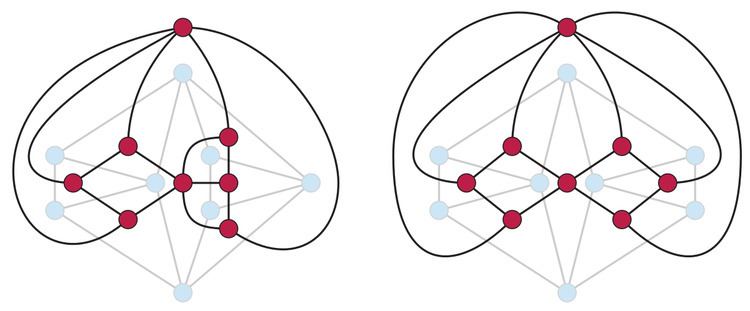 | ||
In matroid theory, a discipline within mathematics, a graphic matroid (also called a cycle matroid or polygon matroid) is a matroid whose independent sets are the forests in a given undirected graph. The dual matroids of graphic matroids are called co-graphic matroids or bond matroids. A matroid that is both graphic and co-graphic is called a planar matroid; these are exactly the graphic matroids formed from planar graphs.
Contents
Definition
A matroid may be defined as a family of finite sets (called the "independent sets" of the matroid) that is closed under subsets and that satisfies the "exchange property": if sets
The bases of a graphic matroid
The lattice of flats
The closure
In this aspect of graphic matroids, the graphic matroid for a complete graph
Representation
The graphic matroid of a graph
If a set of edges contains a cycle, then the corresponding columns (multiplied by
This method of representing graphic matroids works regardless of the field over which the incidence is defined. Therefore, graphic matroids form a subset of the regular matroids, matroids that have representations over all possible fields.
Matroid connectivity
A matroid is said to be connected if it is not the direct sum of two smaller matroids; that is, it is connected if and only if there do not exist two disjoint subsets of elements such that the rank function of the matroid equals the sum of the ranks in these separate subsets. Graphic matroids are connected if and only if the underlying graph is both connected and 2-vertex-connected.
Minors and duality
A matroid is graphic if and only if its minors do not include any of five forbidden minors: the uniform matroid
If a matroid is graphic, its dual (a "co-graphic matroid") cannot contain the duals of these five forbidden minors. Thus, the dual must also be regular, and cannot contain as minors the two graphic matroids
Because of this characterization and Wagner's theorem characterizing the planar graphs as the graphs with no
Algorithms
A minimum weight basis of a graphic matroid is a minimum spanning tree (or minimum spanning forest, if the underlying graph is disconnected). Algorithms for computing minimum spanning trees have been intensively studied; it is known how to solve the problem in linear randomized expected time in a comparison model of computation, or in linear time in a model of computation in which the edge weights are small integers and bitwise operations are allowed on their binary representations. The fastest known time bound that has been proven for a deterministic algorithm is slightly superlinear.
Several authors have investigated algorithms for testing whether a given matroid is graphic. For instance, an algorithm of Tutte (1960) solves this problem when the input is known to be a binary matroid. Seymour (1981) solves this problem for arbitrary matroids given access to the matroid only through an independence oracle, a subroutine that determines whether or not a given set is independent.
Related classes of matroids
Some classes of matroid have been defined from well-known families of graphs, by phrasing a characterization of these graphs in terms that make sense more generally for matroids. These include the bipartite matroids, in which every circuit is even, and the Eulerian matroids, which can be partitioned into disjoint circuits. A graphic matroid is bipartite if and only if it comes from a bipartite graph and a graphic matroid is Eulerian if and only if it comes from an Eulerian graph. Within the graphic matroids (and more generally within the binary matroids) these two classes are dual: a graphic matroid is bipartite if and only if its dual matroid is Eulerian, and a graphic matroid is Eulerian if and only if its dual matroid is bipartite.
Graphic matroids are one-dimensional rigidity matroids, matroids describing the degrees of freedom of structures of rigid beams that can rotate freely at the vertices where they meet. In one dimension, such a structure has a number of degrees of freedom equal to its number of connected components (the number of vertices minus the matroid rank) and in higher dimensions the number of degrees of freedom of a d-dimensional structure with n vertices is dn minus the matroid rank. In two-dimensional rigidity matroids, the Laman graphs play the role that spanning trees play in graphic matroids, but the structure of rigidity matroids in dimensions greater than two is not well understood.
